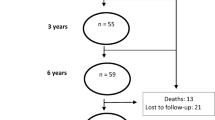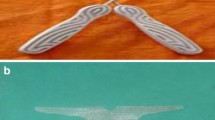Abstract
We compared safety and efficacy of Gynemesh PS® and Pelvicol® for recurrent cystocele repair. One hundred ninety patients were randomly divided into Gynemesh PS® and Pelvicol® groups and underwent tension-free cystocele repair. The Chi-square test was used to compare categorical variables, the paired t test for continuous parametric variables, and the Mann–Whitney test for continuous nonparametric variables. Ninety-six Gynemesh PS® patients and 94 Pelvicol® patients were studied. Mesh erosions occurred in 6.3% of Gynemesh PS® patients. No erosions were observed in Pelvicol® patients (p = 0.02). Objective cure was 71.9% for Gynemesh PS® and 56.4% for Pelvicol® (p = 0.06). Subjective cure was the same in both groups except for better sexuality in the Pelvicol® group. At 24 months follow-up, only Gynemesh PS® patients had mesh erosions. Anatomical outcome was similar in the two groups. Pelvicol® gave a better impact on voiding and sexuality.


Similar content being viewed by others
Abbreviations
- LM:
-
levator myorrhaphy
- POP:
-
pelvic organ prolapse
- POP-Q:
-
pelvic organ prolapse quantification
- PISQ-12:
-
Pelvic Organ Prolapse–Urinary Incontinence Sexual Questionnaire
- TCR:
-
tension-free cystocele repair
References
Boyles SH, Weber AM, Meyn L (2003) Procedures for pelvic organ prolapse in the United States, 1979–1997. Am J Obstet Gynecol 188:108–115
Olsen AL, Smith VJ, Bergstrom JO, Collinq JC, Clark AL (1997) Epidemiology of surgically managed pelvic organ prolapse and urinary incontinence. Obstet Gynecol 87:501–506
Birch C, Fynes MM (2002) The role of synthetic and biologic prostheses in reconstructive pelvic floor surgery. Curr Opin Obstet Gynecol 14:527–535
Norton P, Boyd C, Deak S (1992) Collagen synthesis in women with genital prolapse or stress urinary incontinence. Neurol Urodyn 11:300–301
Rechberger T, Postawsi K, Jakowicki JA (1998) Role of fascial collagen in stress urinary incontinence. Am J Obstet Gynecol 179(6Pt1):1511–1514
Wong MJ, Harmanli OH, Agar M (2003) Collagen content of nonsupportive tissue in pelvic organ prolapse and stress urinary incontinence. Am J Obstet Gynecol 189:1597–1599
Boreham MK, Miller RT, Schaffer JI, Word RA (2001) Smooth muscle myosin heavy chain and caldesmon exp in the anterior vaginal wall of women with and without organ prolapse. Am J Obstet Gynecol 185:944–952
Amid PK (1997) Classification of biomaterials and their related complications in abdominal wall hernia surgery. Hernia 1:15–21
Ridgeway B, Chen CCG, Paraiso MFR (2008) The use of synthetic mesh in pelvic reconstructive surgery. Clin Obstet Gynecol 51:136–152
Le TH, Kon L, Bathia NN, Ostergard DR (2007) Update on the utilization of grafts in pelvic reconstruction surgeries. Curr Opin Obstet Gynecol 19:480–489
Bump RC, Mattiasson A, Bo K, Brubaker LP, DeLancey JO, Karskov P et al (1996) The standardization of terminology of female pelvic organ prolapse and pelvic floor dysfunction. Am J Obstet Gynecol 175:10–17
Digesu GA, Santamato S, Kullar V, Santillo V, Digesu A, Cormio G et al (2003) Validation of an Italian version of prolapse quality of life questionnaire. Eur J Obstet Gynecol Reprod Biol 106:184–192
Roger RG, Coates KW, Kammerer-Doak D, Khalsa S, Qualls C (2003) A short form of the Pelvic Organ Prolapse/Urinary Incontinence Sexual questionnaire (PISQ-12). Int Urogynecol J 14:164–168
Abrams P, Cardozo L, Fall M, Griffiths D, Rosier P, Ulmsten U et al (2002) The standardisation of terminology of lower urinary tract function: report from the standardization sub-committee of the International Continence Society. Neurourol Urodyn 21:167–178
Cervigni M, Natale F, La Penna C, Panei M, Mako (2008) A transvaginal cystocele repair with polypropylene mesh using a tension-free technique. Int Urogynecol J Pelvic Floor Dysfunct 19:489–496
Hiltunene R, Nieminen K, Tarala T, Heiskanen E, Merikari M, Niemi K et al (2007) Low-weight polypropylene mesh for anterior vaginal wall prolapse: a randomized controlled trial. Obstet Gynecol 110:455–462
Nguyen JN, Burchette RJ (2008) Outcome after anterior vaginal prolapse repair: a randomized controlled trial. Obstet Gynecol 111:891–898
Julian TM (1996) The efficacy of Marlex mesh in the repair of severe, recurrent vaginal prolapse of the anterior midvaginal wall. Am J Obstet Gynecol 175:1472–1475
Flood CG, Drutz HP, Waja L (1998) Anterior colporrhaphy reinforced with Marlex mesh for the treatment of cystoceles. Int Urogynecol J Pelvic Floor Dysfunct 9:200–204
de Tayrac R, Gervaise A, Chauveaud A, Fernandez H (2005) Tension-free polypropylene mesh for vaginal repair of anterior vaginal wall prolapse. J Reprod Med 50:75–80
De Tayrac R, Deffieux X, Gervaise A, Chauveaud-Lambing A, Fernandez H (2006) Long-term anatomical and functional assessment of the trans-vaginal cystocele repair using a tension-free polypropylene mesh. Int Urogynecol J Pelvic Floor Dysfunct 18:251–256
Debodinance P, Berrocal J, Clavè H, Cosson M, Garbin O, Jacquetin B et al (2004) Changing attitudes on the surgical treatment of urogenital prolapse: birth of the tension-free vaginal mesh. J Gynecol Obstet Biol Reprod 33:577–588
Deffieux X, de Tayrac R, Huel C, Bottero J, Gervaise A (2007) Vaginal mesh erosion after trans-vaginal repair of cystocele using Gynemesh or Gynemesh-Soft in 138 women: a comparative study. Int Urogynecol J 18:73–79
Jakus SM, Shapiro A, Hall CD (2008) Biologic and synthetic graft use in pelvic surgery: a review. Obstet Gynecol Survey 63:253–266
David-Montefiore E, Barranger E, Dubernard G, Detchev R, Nizard V, Darai E (2005) Treatment of genital prolapse by hammock using porcine skin collagen implant (Pelvicol). Urology 66:1314–1318
Meschia M, Pifarotti P, Bernasconi F, Magatti F, Riva D, Kocjancic E (2007) Porcine skin collagen implants to prevent anterior vaginal wall prolapse recurrence: a multicenter, randomized study. J Urol 177:192–195
Handel LN, Frenkl TL, Kim JH (2007) Results of cystocele repair: a comparison of traditional anterior colporrhaphy polypropylene mesh and porcine dermis. J Urol 178:153–156
Gauruder-Burmester A, Koutouzidou P, Rohne J, Gronewold M, Tunn R (2007) Follow-up after polypropylene mesh repair of anterior and posterior compartments in patients with recurrent prolapse. Int Urogynecol J 18:1059–1064
Davila GW, Drutz D, Deprest J (2006) Clinical implications of the biology of the grafts: conclusions of the 2005 IUGA Grafts Roundtable. Int Urogynecol J 17:S51–S55
Lemack GE, Zimmern PE, Blander DS (2000) The levator myorrhaphy repair for vaginal vault prolapse. Urology 56:50–54
Conflicts of interest
None.
Author information
Authors and Affiliations
Corresponding author
Rights and permissions
About this article
Cite this article
Natale, F., La Penna, C., Padoa, A. et al. A prospective, randomized, controlled study comparing Gynemesh®, a synthetic mesh, and Pelvicol®, a biologic graft, in the surgical treatment of recurrent cystocele. Int Urogynecol J 20, 75–81 (2009). https://doi.org/10.1007/s00192-008-0732-6
Received:
Accepted:
Published:
Issue Date:
DOI: https://doi.org/10.1007/s00192-008-0732-6




